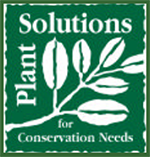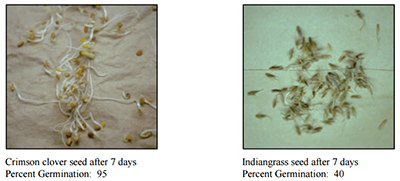Agricultural Literacy Curriculum Matrix
Companion Resource

How to Use a Ragdoll Test to Estimate Field Germination
Germinate seeds like a pro! The ragdoll germination test involves placing a known number of seeds in a moist paper towel, rolling up the towel and seeds to place inside a plastic bag, and assessing the number of seeds that germinate over the next few days. This is an easy way to demonstrate germination in the classroom and to test and discuss factors that affect germination.
Materials
- Seeds (e.g., wheat, millet, or alfalfa)
- Paper towels (the nonquilted paper towels typically found in schools work best)
- Plastic bags
Procedures
Background
Laboratory germination tests provide the end user with useful information on the germination potential of various types of seeds. These tests are conducted using standardized procedures developed by the Association of Official Seed Analysts (AOSA, 1993). A typical germination test using AOSA rules involves placing a known number of seeds in a petri dish or similar container between or on top of blotter or filter paper. Seeds are moistened with water or a combination of water and chemicals and placed in a growth chamber or germinator. A specific temperature and light setting for each species creates an ideal germination environment for optimum germination. Seeds are germinated for a predetermined number of days, with counts made periodically until the end of the testing period. The percent germination is then printed on the tag along with other important information about the seed lot such as percent purity, weed seeds, other crop seeds, dormant or hard seeds, noxious weed seeds, and inert matter. These seed statistics, which accompany each bag of seed, are used to calculate seeding rates.
Native warm season grass, legume and wildflower seeds have a high level of dormancy that can often hinder establishment. This dormancy is a built in defense mechanism to prevent the seed from germinating until favorable conditions exist for germination, seedling growth and development. Exposing the seed to cold wet conditions can overcome this dormancy and greatly improve germination. This process is called stratification, and involves mixing seeds with moist sand, peat or other mediums and storing at temperatures between 2°C (35°F) and 5°C (41°F) for different time intervals (Beinz, 1980). In laboratory tests, native grass seeds are routinely stratified prior to conducting an official germination test. Because most conservation plantings are made with dry, non-stratified native grass, legume and wildflower seeds, the germination percentage on the seed tag may not necessarily reflect the germination percentage under field conditions. For example, if the seed tag indicates 90 percent germination, it should not be construed that 90 percent of the seeds in the bag are going to germinate in the field. It means that under ideal conditions, 90 percent of the seeds have the potential to germinate.
A simple way to get an idea of the actual field germination prior to planting is to conduct a “ragdoll” test. A “ragdoll” consists of a rolled tube of moistened paper containing the seeds to be tested for germination, placed in plastic bag and stored in a warm place for several days. Seedlings are counted as they germinate and are removed, giving the percentage of actual germination. The following procedures and helpful suggestions were modified from previous experience and those prepared by Parish et al. (2000).
Ragdoll Germination Test
- Use two, firm paper towels such as a brown hand towel or its equivalent. The “soft” very absorbent paper toweling often used in a kitchen make poor ragdolls. They allow roots and tops to penetrate the fiber, making seedlings difficult to remove for counting. Regardless of which type of towel is used, it is necessary to squeeze all excess water from the towels to prevent seed rotting. Too much water causes a lack of oxygen; growth of roots of will be more retarded than that of shoots under these conditions.
- After the towel has been squeezed rather firmly, lay it flat. (a) Count out 100 seeds and place them on half of the towel or, if seeds are difficult to count accurately, place a small quantity of seeds on the towel. (b) Fold the towel in half and roll it into a round tube. (c) Place the tube inside a plastic bag and seal it. Place the plastic bag in a warm place, preferably on top of a refrigerator. A temperature of 30 °C (85°F) is recommended, but seeds will germinate at room temperature (21°C or 70°F).

- Make the first count in about 4 days. Open the towel, count the seedlings and remove them. After another 3 to 4 days, make a second count. When 100 seeds were used, the number of seeds removed equals the percentage of germination. If seeds were not counted initially, count the remaining seeds and calculate the germination percentage.
% germination = ((# seeds germinated) / (# seeds germinated + # seeds remaining)) x 100
It is a good idea to retain a small amount of seed lots that were planted so if the desired stand was not achieved, you can check germination again to be sure whether or not the problem was due to bad seed. If seeds do not germinate in the environmental conditions of a properly prepared ragdoll, do not expect much success when planting them in the field. Another good idea is to test the conditions in the ragdoll by adding a few seeds of wheat, millet or alfalfa that will germinate in high percentages and under wet conditions. If these seeds germinate well, the ragdoll is working properly. If the seedlings are stunted, then the ragdoll may be too wet for the seed you are testing. The old saying “practice makes perfect” definitely applies here. It may take several trials and errors before mastering the procedure. With practice, the ragdoll test can be a useful method for determining field germination potential of many types of grass, legume and wildflower seeds and adjustments can be made in seeding rates to improve stands.
Another good idea is to test the conditions in the ragdoll by adding a few seeds of wheat, millet or alfalfa that will germinate in high percentages and under wet conditions. If these seeds germinate well, the ragdoll is working properly. If the seedlings are stunted, then the ragdoll may be too wet for the seed you are testing. The old saying “practice makes perfect” definitely applies here. It may take several trials and errors before mastering the procedure. With practice, the ragdoll test can be a useful method for determining field germination potential of many types of grass, legume and wildflower seeds and adjustments can be made in seeding rates to improve stands.
File, Map, or Graphic
Author
Organization
Sources
This publication comes from the USDA-NRCS Jamie L. Whitten Plant Materials Center in Coffeeville, MS.
